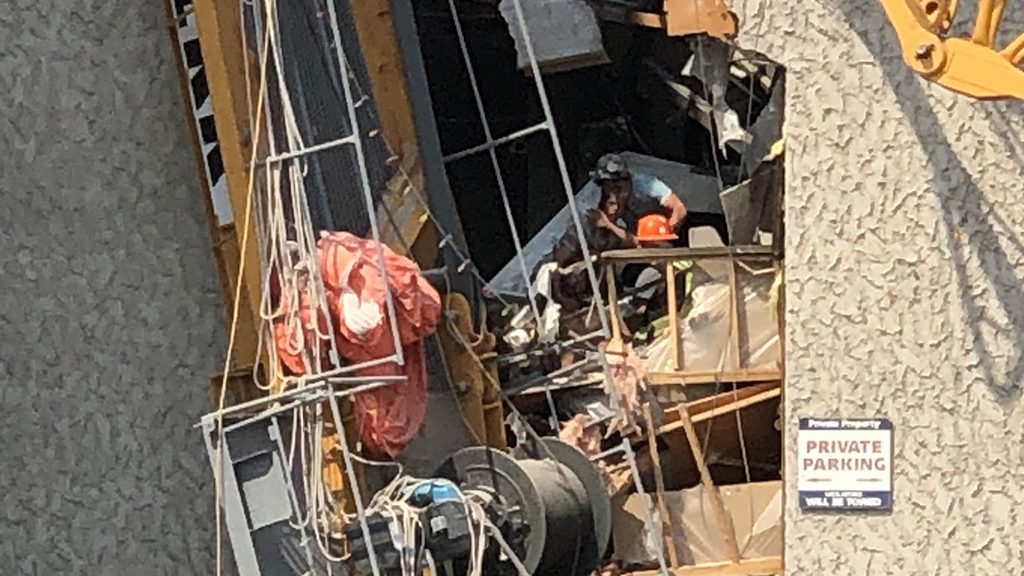BC Crane Safety executive director Clinton Connell said because of previous crane incidents in the U.S. and across the world discussions were already occurring before the tragic crane collapse in Kelowna on July 12.
A recent crane collapse in Seattle on April 27, 2019 where four people were killed and four others were injured spurred the industry to renewed discussion of crane safety, Connell said.
“The Seattle incident being so recent caused an impetus for discussions to start. Out of that came a Vancouver pilot project,” he said.
Connell added a B.C. crane conference group had started prior to the Seattle incident and “after Seattle we had the next tower crane conference, and the seeds were planted for how to do things differently.”
“We launched the tower crane pilot project with the City of Vancouver in May 2021 and then Kelowna happened,” he said.
“The first thing I did (when Kelowna happened) was tell the City of Vancouver that the pilot project was no longer a pilot. It created an urgent need to get that program in the hands of health and safety managers the next day,” Connell said.
The pre-assembly pilot project is a collaboration between the City of Vancouver and BC Crane Safety and focuses on safe assembly and disassembly of tower cranes through improved communication between t various stakeholder parties. The project includes a checklist accompanying permit applications to assemble a crane.
“The good new is it wasn’t starting from scratch, or saying ‘what do we do now?’ These conversations had already started.”
The crane operating industry is small and close-knit, Connell said. As a result the Kelowna crane collapse was “devastating.”
“Everyone knows each other, and we feel each other’s pain,” he said.
BC Crane Safety has representatives at the table from every part of the industry and the Kelowna incident put everyone on notice to have their subject matter ready and be prepared to sit down with the provincial government and regulators.
“In the meantime, we’ll stay with the pilot project, but be proactive and not wait for regulatory changes to put in the work,” Connell said.
Connell suggested a registry and certification for those capable of assembly and disassembly of cranes is one possible course of action.
“Tower crane operators are certified, so why not regulate those putting them up and taking them down?” he asked.
Connell likened cranes to airplane engines in that an airplane mechanic can’t know the working of every engine and must be specialized.
“Manufacturer training is big part of the crane world. It’s so specialized that training comes direct from the manufacturer,” he said.
BC Crane Safety recently published an annual report and Connell said the Kelowna crane collapse has not changed the report’s stated goals which are “hammered out three years at a time.”
The Kelowna incident just reinforces what the industry is already working on, Connell said.
“Everyone has pretty solid ideas and all the stakeholders are sitting around the discussion table. If this incident leads to new regulations, legislative change would take three to five years to implement. We as an industry don’t want to wait three to five years,” he said.
A registration system already exists, he added, and it can be modified and applied to crane assemblers and disassemblers.
BC Crane Safety also recently released new fall protection resources including a fillable template and companion guide designed to allow employers to create a fall protection plan for their workers.
The template includes spaces for a project site description, site specific details for work at heights, worksite details, types of fall protection systems and procedures, rescue procedures and a record of review.
“Tower cranes, window washers and power washers are all highly specialized work. WorkSafeBC is a wealth of resources but it represents the entire spectrum of working,” Connell said. “Stepping into a library isn’t always useful when all you need is a newspaper.
“We want to get those resources front and centre. Industry funds our existence and we want to make sure we have useful resources for them to utilize, especially concerning public safety,” Connell said.
Follow the author on Twitter @JOCFrey.











Recent Comments
comments for this post are closed